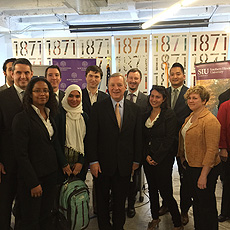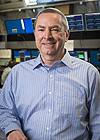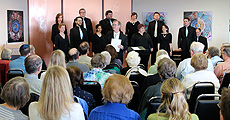|
|
Senator Durbin receives Champion of Science Award
 |
| Researchers from Fermilab congratulated Senator Richard Durbin on his Champion of Science Award, presented by The Science Coalition on March 16 in Chicago. From left: Brian Nord, Charlie Cooper, Marcelle Soares-Santos, Jim Hirschauer, Farah Fahim, Alex Romanenko, Senator Richard Durbin, Tim Meyer, Anna Grassellino, Nhan Tran, Jen Raaf. Photo: Tracey Quinn, University of Chicago |
On Monday, The Science Coalition honored Senator Richard Durbin with its Champion of Science Award in recognition of his strong commitment to funding the basic research that keeps the United States and the state of Illinois at the forefront of scientific discovery and technological innovation.
The award was presented to Senator Durbin at an event at 1871, a co-working center for digital startups in Chicago. Leaders from the five Science Coalition member universities in Illinois joined together to present the award.
|
University of Notre Dame hosts Rock the LHC contest, prize is trip to Fermilab
 |
| The University of Notre Dame is accepting video submissions for its Rock the LHC video contest between March 23 and May 31. |
Beginning March 23, the University of Notre Dame will accept submissions for a new video contest titled Rock the LHC.
Videos should focus on the excitement of particle physics research at the Large Hadron Collider, or in short, why the LHC rocks. Video submissions must be two minutes or less.
The winning video earns a trip for two from the continental United States to visit Fermilab, just outside Chicago.
Video submissions will be accepted between March 23 and May 31.
Learn more at the Rock the LHC website.
|
Einstein's most famous equation
 |
| You've heard of Einstein's E=mc2, but what does it mean? Image: Chris Smith, SLAC National Accelerator Laboratory |
With Einstein's birthday [on March 14 (which also happened to be Pi Day)], it seems appropriate to take a fresh look at one of his biggest accomplishments with a short video.
In 1905, Einstein published four papers that radically changed how we look at the world around us. Dubbed Einstein's "Annus Mirabilis," or "Year of Wonders," it gave us revolutionary new ideas about light, atoms and how your frame of reference makes a big difference in your perception.
It was Einstein's final paper that year that really took the (birthday) cake. In it, he gave us a deceptively simple idea—that mass and energy were equivalent. He even summed it up for us with the tiny equation E=mc2.
However, while appearing simple, the implications of E=mc2 are huge and far-reaching. To find out why, sit back, enjoy some birthday cake (or pie, depending on how you're celebrating), and watch the video!
Watch the two-and-a-half-minute video
—Chris Smith
|
Superconductors could help physicists find 'gravity particles'
From Live Science, March 12, 2015
It may be possible to draw energy from a vacuum using gravity, a theoretical physicist says.
If researchers succeed in showing that this can happen, it could prove the long-postulated existence of the graviton, the particle of gravity, and perhaps bring scientists one step closer to developing a "theory of everything" that can explain how the universe works from its smallest to largest scales.
Read more
|
|
Mu2e construction shifts into high gear
 |
Fermilab Director
Nigel Lockyer
|
The search for charged-lepton flavor violation just moved a step closer. If this phenomenon is uncovered by the Mu2e experiment and its global collaboration, our understanding of particle physics would increase substantially.
The Mu2e project achieved two major milestones earlier this month, advancing this quest along its path for science early in the next decade.
Based on developments in detailed designs, engineering analyses and magnet prototyping validated by an independent review committee, Mu2e received Critical Decision 2 and Critical Decision 3b approval from the U.S. Department of Energy Office of Science on March 4. These important decisions mark the approval of the budget, schedule and scope proposed by the Mu2e team. They also mark the authorization of the construction of the detector hall at Fermilab and the modules that make up the experiment's s-shaped transport solenoid magnets.
DOE critical decisions don't just happen. They require a significant and prolonged effort from a large group of talented and committed individuals. In the lead-up to the latest critical decision, Mu2e scientists, engineers, technicians and other specialists demonstrated their understanding of the experimental apparatus and its associated accelerator and beamline elements and prototyped key components. One part of the team was involved in 8 million CPU hours simulating the detector performance. In addition to these milestones in the lab and on the screen, the project team demonstrated management proficiency, generated a credible cost and schedule, and produced a 900-page technical design.
The project team and experimental collaboration will celebrate these decisions and the start of construction at a groundbreaking ceremony scheduled for April 18. In the meantime, attention is already turning to the next project milestone: CD-3c in the summer of 2016, authorizing construction of the remainder of the Mu2e apparatus.
Thank you to everyone who played a role in this lab achievement.
|
Spring ahead
 |
| This beautiful spring-like morning scene was captured at the corner of Wilson Street and Road B. Photo: Tom Nicol, TD |
|
St. Charles Chamber Singers fill art gallery on Sunday
 |
| The St. Charles Chamber Singers performed for a crowd on Sunday in the Fermilab Art Gallery. Photo: Georgia Schwender, OC |
On Sunday, the St. Charles Chamber Singers performed for an appreciative audience as part of the Fermilab Gallery Chamber Series.
Led by Jeffrey Hunt, the ensemble performed works by Mozart, Verdi and Pentatonix, as well as some spirituals.
Visit the Fermilab Cultural Events Series Web page to learn more about concerts like these at the laboratory.
|
Hopped-up particle accelerator poised to venture into the realm of exotic physics
From Scientific American, March 11, 2015
Physicists are getting antsy. Their most highly prized tool for studying the smallest bits of nature — the Large Hadron Collider (LHC) particle accelerator — has been shut down since the end of 2012 for $163 million worth of upgrades. But within two months it will be back with a vengeance, colliding protons at mind-numbing energies that have never been achieved in a man-made machine. Physicists hope that these energies will be enough to produce new particles or phenomena that expose secrets the universe has thus far been unwilling to give up. In particular, the upcoming run at the LHC could yield evidence for an idea called supersymmetry, which would be upheld if extra particles and dimensions of matter show up — and which would explain many puzzling facets of the cosmos.
Read more
|
|